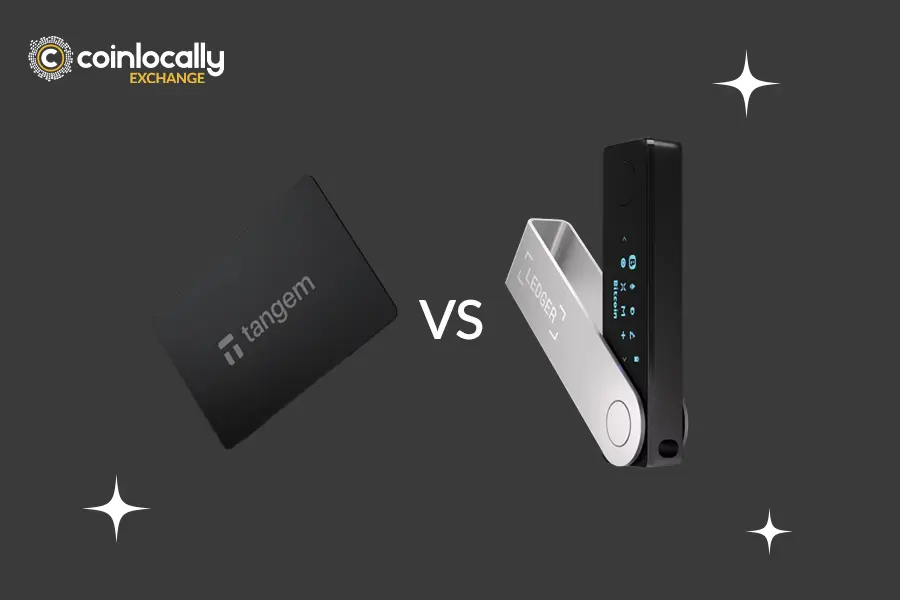Tangem vs Ledger is a popular comparison for those seeking a secure and user-friendly crypto wallet. It is no secret that selecting a trustworthy wallet is crucial for safeguarding your digital assets. Tangem vs Ledger is a key matchup when comparing options, as each offers unique features that focus on security, usability, and performance. This article compares and contrasts these two wallets to determine which suits your crypto needs best.
Table of Contents
Ledger and Tangem: Key Takeaways
To begin with, Tangem features a distinctive card-like design and does not require batteries.
Meanwhile, Ledger offers advanced hardware wallet functionalities.
Although both provide robust security, their approaches differ significantly.
In terms of supported cryptocurrencies, Ledger offers a broader range.
On the other hand, Tangem is more budget-friendly, whereas Ledger is priced higher due to its premium features.
Ledger vs Tangem: Wallet Design and Features
Although both wallets are designed for secure cryptocurrency storage, they cater to different types of users. For instance, the table below outlines their differences in terms of form, functionality, and usability—key areas of discussion for these two wallets.
| Feature | Tangem | Ledger |
|---|---|---|
| Design | Card-like, no battery | USB-like, rechargeable |
| Security | EAL6+ certification | Secure Element EAL5+ |
| Supported Coins | Over 6,000 | Over 5,500 |
| Price | ~ $40 per card | ~ $149 |
| Battery | Not required | Rechargeable |
| Platforms | iOS, Android | Windows, macOS, iOS, Android |
Tangem vs Ledger: Device Comparison – Nano X and Nano S
Advanced Option – Ledger Nano X
To begin with, this model includes Bluetooth functionality for easy mobile use. Additionally, it supports thousands of cryptocurrencies and features a secure element chip (EAL5+). Moreover, the device runs on a rechargeable battery that lasts up to 8 hours. As a result, it’s a flexible choice in the debate between these two wallets for mobile-focused users.
Entry-Level Option – Ledger Nano S
Designed as an entry-level wallet, this model lacks Bluetooth but still supports over 5,500 assets.
Therefore, it’s a cost-effective option for users seeking basic but reliable functionality.
While it lacks some advanced tools, it still competes well in this two-wallet space.
Tangem vs Ledger: Tangem Wallet Overview
Tangem’s card-shaped design is both minimalistic and durable, making it visually and functionally distinct in the Tangem vs Ledger Tangem comparison. Moreover, it eliminates the need for charging and is tamper-resistant.
This design approach is one reason some users prefer Tangem in this two-wallet comparison.
- No batteries or cables required
- EAL6+ smart card security standard
- Supports over 6,000 digital currencies
- Comes with its own mobile app
- Built for physical resilience
Tangem vs Ledger: Security Comparison
Tangem ensures secure key generation and storage directly on the card. Notably, the private key never leaves the device. For this reason, for users focused strictly on hardware-level security, this is a point in favor of Tangem.
On the other hand, Ledger uses a secure chip (EAL5+) and the BOLOS operating system. With PIN code access and a recovery phrase, it adds multiple layers of protection.
Thus, Ledger has a strong edge for users needing comprehensive backup and recovery in this two-wallet matchup.
Tangem vs Ledger: Crypto Support and Integration
Tangem covers over 6,000 digital assets, including both leading and emerging cryptocurrencies. As a result, this wide range appeals to users managing diverse portfolios.
Ledger, on the other hand, supports a slightly smaller number of coins but integrates deeply with DeFi and NFT tools. As a result, Ledger holds significant value for advanced users, making it a powerful player in the discussion of these two wallets.
Tangem vs Ledger: Price Comparison
Tangem is attractively priced at around $40 per card, which makes it ideal for budget-conscious users. In fact, its affordability is one of its major strengths in the Tangem vs Ledger comparison.
Ledger Nano X, with its advanced features, retails for approximately $149. Meanwhile, the Ledger Nano S, priced at $79, offers a balance between cost and utility.
Although it costs more, Ledger offers more advanced tools and integrations, which help offset the higher price.
Tangem vs Ledger: Battery Life and Charging
Tangem’s design is completely battery-free, offering long-term convenience.
Therefore, it’s a zero-maintenance choice for users focused on simplicity.
In contrast, Ledger Nano X requires charging and delivers up to 8 hours of standby time.
Battery capacity, in this case, is a deciding factor for users evaluating Tangem vs Ledger in terms of device independence.
Tangem vs Ledger: Cross-Platform Compatibility
Tangem supports both iOS and Android, with a primary focus on mobile users.
This platform limitation may be a factor for users comparing the flexibility of Tangem vs Ledger.
Ledger is compatible with desktop and mobile platforms, including Windows and macOS, making it a versatile choice. As a result, this broader compatibility appeals to users working across multiple devices.
Tangem: Pros and Cons
Pros:
- Affordable and lightweight
- No charging required
- Strong smart card security
- Easy to carry
Cons:
- Mobile-only usage
- Limited advanced features
Why Choose Tangem?
Tangem is an excellent choice for beginners or anyone seeking simplicity, mobility, and low maintenance in the context of Ledger vs Tangem evaluations. Additionally, in the Tangem vs Ledger decision-making process, it’s the go-to option for users seeking a straightforward experience. It also prioritizes ease of use without sacrificing security.
Ledger: Pros and Cons
Pros:
- Wide crypto asset support
- Features like Bluetooth and BOLOS OS
- Works across desktop and mobile
- Multi-layered security approach
Cons:
- Higher price range
- Needs regular charging (Nano X)
Why Choose Ledger?
Ledger is best suited for users requiring advanced features and compatibility with decentralized apps and NFTs, a key differentiator in the Ledger vs. Tangem decision process. Furthermore, it’s a powerful option for experienced traders managing large portfolios. In summary, in the Ledger vs Tangem landscape, Ledger is the robust tool for power users.
Final Thoughts on Tangem vs Ledger
Both wallets offer strong security and broad asset support. However, Tangem wins on simplicity and price, while Ledger excels in versatility and advanced features. Ultimately, your choice in the Ledger vs Tangem debate depends on whether you value ease of use or depth of functionality.




